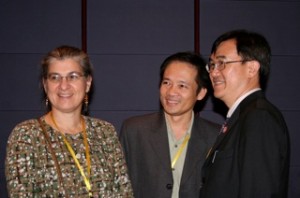Financing and Marketing Sanitation in Developing Nations
Financing and Marketing Sanitation in Developing Nations
Meeting Demand. Jon Lane of the Geneva-based Water Supply and Sanitation Coordinating Council introduced the World Sanitation Financing Facility. Under the leadership of Arthur Wood, people in sanitation, social innovation, finance, commerce and the law are collaborating to make sanitation an economic activity. WSFF is a shift from top down, supply-driven, charity-oriented, grant-based approaches and efforts to meeting the unmet demand of households in the developing world that stand ready to spend $80 billion over the next 10 years.
Lane noted that for years, we’ve expected people to want build their own toilets when local entrepreneurs can do a much better job both in construction and servicing. Now that the composting of human feces is becoming socially acceptable, there’s a need for on the ground specialists in decentralized eco-san and closed loop systems.
You use what you choose. Three speakers then defined the area of Sanitation Marketing, or San Mark. Mini Jenkins of the University of California at Davis talked about the supply side gap, or why behavior change models that try to get people to adopt toilets just don’t work. Likewise subsidies fail; they are captured by the non-poor and often push inappropriate tech. The health education approach is also of limited effectiveness because non-health drivers are simply more powerful. People use what they choose.
So, says Jenkins, stimulate demand by interesting consumers in new technologies through information and education. At the same, develop market-based supply through market research, R & D, understanding producers and their skills, building capacity, and endorsing or certifying service providers.
Sell dreams not latrines. Next IDE Vietnam Country Director Nguyen Van Quang gave a most interesting presentation on the experiences of his organization. Sell dreams, not latrines, the Willamette University MBA said. Use emotional triggers rather than talk about function or health. Use person to person communication. Encourage “being an explemplary person in a cultured village.” SanMark rejects subsidies and holds that the purchasing power of the poor should be underestimated.
Ari Kamasan of WSP-World Bank Indonesia then demonstrated how a marketing mix was able to scale up supply and demand for improved sanitation in East Java. Success indicators include 49% increase in improved sanitation, 715 villages becoming ODF (Open Defecation Free), capacity built in 29 local governments, and 1,740 masons trained and set up in business.
Meeting Demand. Jon Lane of the Geneva-based Water Supply and Sanitation Collaborative Council introduced the World Sanitation Financing Facility under the leadership of Arthur Wood. WSFF brings together people in sanitation, social innovation, finance, commerce and the law to make sanitation an economic activity. This represents a shift a shift from top down, supply-driven, charity-oriented, grant-based approaches and efforts to meeting the unmet demand of households in the developing world that stand ready to spend $85 billion over the next 10 years.
Lane noted that for years we’ve expected people to want build their own toilets when they just might not want to and when local entrepreneurs can do a much better job both in construction and servicing. And now that the composting of human feces is becoming socially acceptable, there’s a need for on the ground specialists in decentralized eco-san and closed loop systems.
People use what they choose. Three speakers then defined the area of Sanitation Marketing, or San Mark. Mini Jenkins of the University of California at Davis talked about the supply side gap, or why behavior change models that try to get people to adopt toilets just don’t work. Likewise subsidies fail; they are captured by the non-poor and often push inappropriate tech. The health education approach is also of limited effectiveness because non-health drivers are simply more powerful. People use what they choose.
So, says Jenkins, stimulate demand by interesting consumers in new technologies through information and education. At the same, develop market-based supply through market research, R & D, understanding producers and their skills, building capacity, and endorsing or certifying service providers.
Sell dreams, not latrines. Next Nguyen Van Quang, Country Director for International Development Enterprises, the international NGO founded by Paul Polak, gave a most interesting presentation on the experiences of his organization. “Sell dreams, not latrines,” the Willamette University MBA said. Use emotional triggers rather than talk about function or health. Use person to person communication. Encourage “being an explemplary person in a cultured village.” SanMark rejects subsidies and holds that the purchasing power of the poor should be underestimated.
Scaling up demand and supply. Ari Kamasan of WSP-World Bank Indonesia then demonstrated how a marketing mix was able to scale up supply and demand for improved sanitation in East Java. Success indicators include 49% increase in improved sanitation, 715 villages becoming ODF (Open Defecation Free), capacity built in 29 local governments, and 1,740 masons trained and set up in business. 
